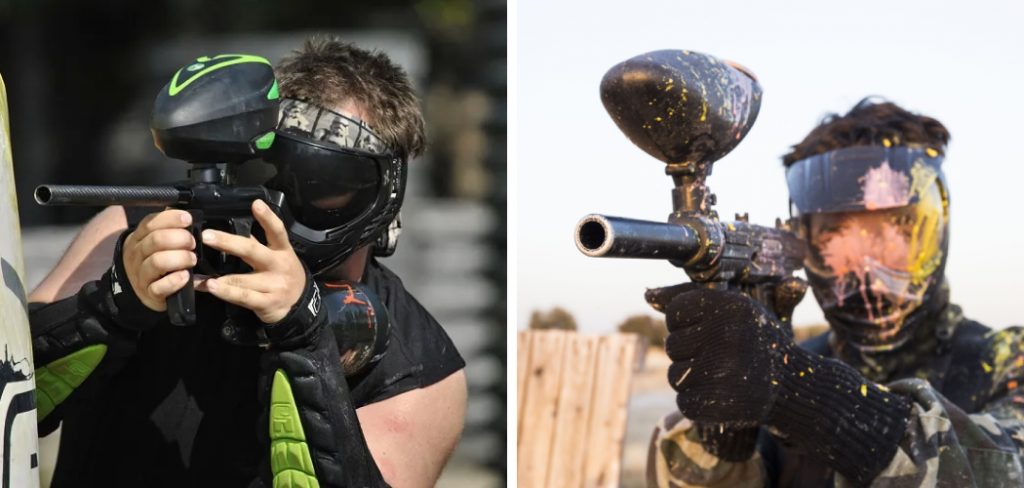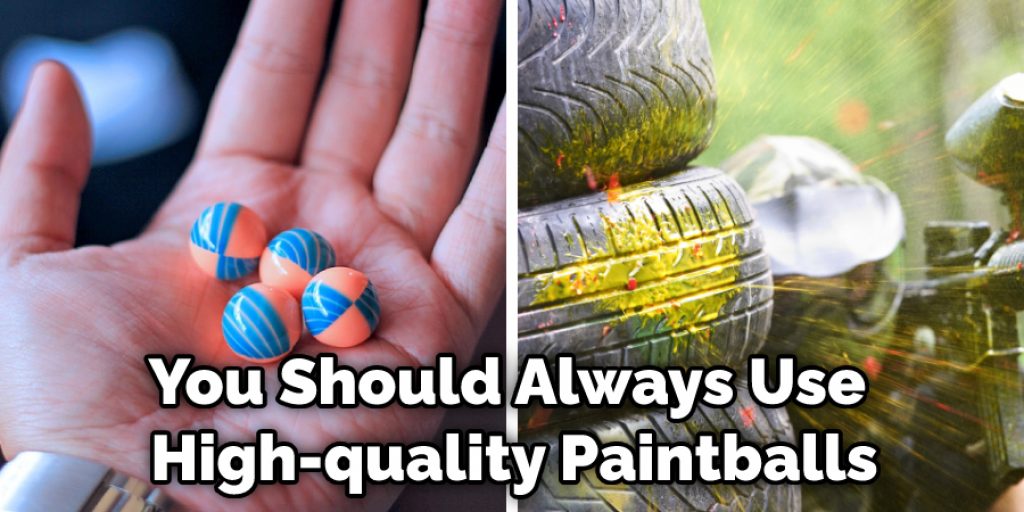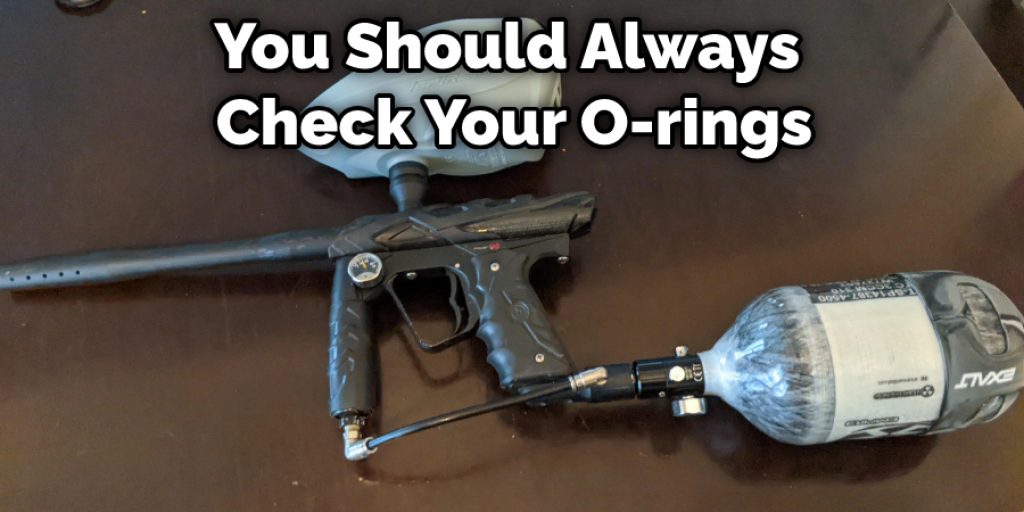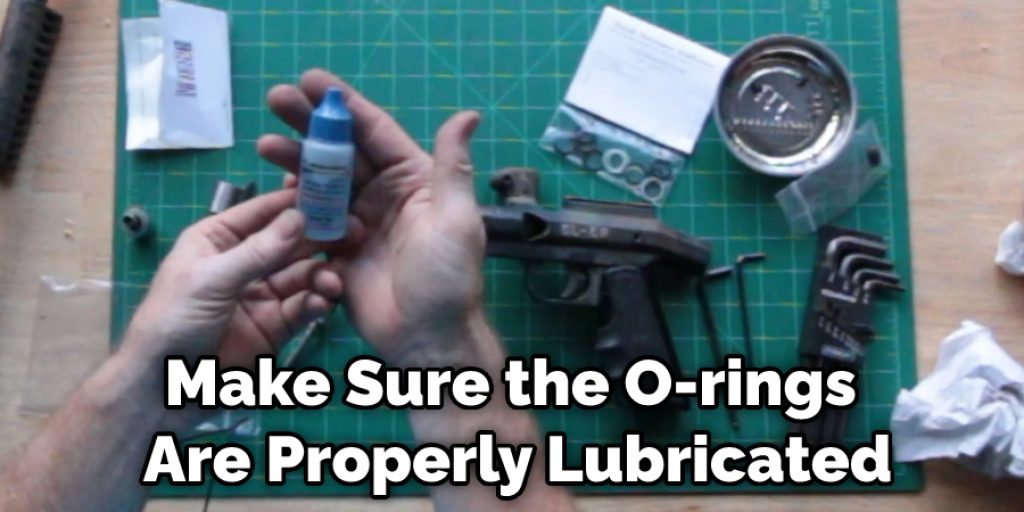Has your paintball gun been giving you trouble lately? It might not be shooting because of a problem with the paintball itself, but rather with the gun itself. In this blog post, we will discuss why a paintball gun might not be shooting and how to fix it.
Several things can cause a paintball gun not to shoot, and we will cover each of them in detail. So whether you are a beginner or an experienced player, read on to learn how to fix a paintball gun that won’t shoot!
Summary: If your paintball gun doesn’t shoot, you can take several easy steps to fix it. First, check the air source and tank o-rings. Then, check the hoses and fittings, along with the paintballs. Check for a jam in the barrel and hopper, and look out for any leaks in the system. Adjust the marker’s velocity or replace worn or damaged parts if needed.

10 Common Problems That Are Found in Paintball Gun
1. Lack of Compressed Air:
This is the most common reason why a paintball gun won’t shoot. Most guns require at least 800 psi of compressed air to function properly. If your gun doesn’t have enough pressure, it simply won’t fire.
2. Dirty Barrel:
A paintball gun will not shoot properly if there is dirt or debris in the barrel. This can cause a paintball to get lodged in the barrel, preventing firing. To clean your barrel, use a barrel swab or snake. Swab the inside of your barrel until the swab comes out clean. If you do not have a barrel swab, you can use a paper towel or cotton swab dipped in alcohol.
Another reason a paintball gun may not shoot properly is if there is something blocking the airflow. Check to ensure nothing is blocking your gun’s air intake port. Also, check to see if the O-rings are in good condition and are not dry or cracked.
3. Broken Paintballs:
If you use broken paintballs, they might not fit your gun’s barrel correctly. This could cause a paintball to get stuck in the barrel, preventing the gun from firing. It’s a good idea always to use high-quality paintballs that are the right size for your gun’s barrel.
4. Leaking Paintballs:
If your paintballs are leaking, they will not be able to seal properly in the barrel. This can cause a paintball to get lodged in the barrel, preventing it from firing. Therefore, you should always use high-quality paintballs sized correctly for your gun’s barrel. Can You Shoot a Paintball Gun Without a Barrel?
It is not recommended to shoot a paintball gun without a barrel. A barrel helps to contain and direct the paintballs as they are fired. Without a barrel, paintballs can veer off in different directions, which can be dangerous.
5. Incorrect Paintball Size:

If you are using paintballs that are too small or too large for your gun’s barrel, they will not be able to seal properly. This can cause a paintball to get lodged in the barrel, which will prevent it from firing. Therefore, you should always use high-quality paintballs that are the correct size for your gun’s barrel.
6. Paintballs Are Too Dry:
If your paintballs are too dry, they may not fire correctly. Try adding a little bit of water to your paintballs and see if that helps. You can also try using a different brand of paintballs. If your paintballs are too old, they may not fire correctly. Try using a different brand of paintballs.
7. The Barrel Is Blocked:
If your paintball gun’s barrel is blocked, the paintballs will not be able to come out. Try cleaning your barrel with a barrel swab and some compressed air. You may also need to replace your barrel if it is damaged.
8. The Paintballs Are Old:
If your paintballs are old, they might have lost their round shape or have cracks in them. This can cause your paintball gun to misfire. It would help if you always used fresh paintballs to ensure that they will fire correctly.
9. Wrong CO2 Cartridge:
One of the most common problems with paintball guns is using the wrong type of CO2 cartridge. First, ensure you’re using your gun’s correct cartridge type. If you’re not sure, consult the manual or ask a professional.
10. Damaged O-rings:
If your gun’s O-rings are damaged, they might not be able to create a seal. This can cause your paintball gun to misfire. Therefore, you should always check your O-rings for damage and replace them if necessary.

10 Effective Ways on How to Fix a Paintball Gun That Won’t Shoot
Step 1: Gather Necessary Tools and Materials
To fix a paintball gun that won’t shoot, you may need the following tools and materials:
- Owner’s manual or repair guide for your paintball gun
- Allen wrench set
- Screwdriver (Phillips or flathead, depending on your gun)
- Replacement O-rings
- Paintball gun lubricant
- Clean cloth or paper towels
- Compressed air or CO2 tank with adequate pressure
- Paintballs of the appropriate caliber
Step 2: Engage the Safety and Remove the Air Source
Before working on your paintball gun, engage the safety mechanism and disconnect the air source, such as a CO2 or compressed air tank, to prevent accidental firing during the repair process.
Step 3: Inspect the Paintball Gun for Obvious Issues
Visually inspect your paintball gun for any obvious issues that may be preventing it from firing, such as:
- Broken or damaged paintballs in the chamber or barrel
- Debris or dirt inside the gun
- Damaged or loose components
- Low or empty air source
Step 4: Clean the Barrel and Chamber
a. Remove the barrel from the paintball gun, following the instructions in your owner’s manual or repair guide.
b. Use a barrel swab, squeegee, or soft cloth to clean any paint, debris, or dirt from the inside of the barrel and the chamber.
c. Reattach the barrel to the paintball gun, ensuring it is properly aligned and securely fastened.
Step 5: Check the Air Source
a. Ensure that your CO2 or compressed air tank has adequate pressure. If the pressure is too low, the gun may not fire properly. Refill or replace the tank as needed.
b. Inspect the air source connection for any leaks, damaged O-rings, or loose fittings. Replace any damaged components and ensure the connection is secure.
Step 6: Inspect and Clean the Bolt Assembly
a. Consult your owner’s manual or repair guide for instructions on how to remove the bolt assembly from your paintball gun.
b. Inspect the bolt assembly for any signs of wear, damage, or debris. Clean any dirt or paint residue from the assembly using a cloth or paper towel.
c. If the O-rings on the bolt assembly are damaged or worn, replace them with new O-rings of the appropriate size.
d. Apply a thin layer of paintball gun lubricant to the bolt assembly, focusing on the O-rings and any moving parts.
e. Reinstall the bolt assembly into the paintball gun, following the instructions in your owner’s manual or repair guide.
Step 7: Check the Trigger and Sear
a. Inspect the trigger mechanism for any signs of wear, damage, or debris. Clean any dirt or paint residue from the trigger components using a cloth or paper towel.
b. Ensure that the sear, which catches the bolt and releases it when the trigger is pulled, is properly aligned and functioning. If the sear is worn or damaged, it may need to be replaced.
Step 8: Inspect and Clean the Regulator
a. Consult your owner’s manual or repair guide for instructions on how to remove and disassemble the regulator on your paintball gun.
b. Inspect the regulator components for any signs of wear, damage, or debris. Clean any dirt or paint residue from the components using a cloth or paper towel.
c. If the O-rings on the regulator are damaged or worn, replace them with new O-rings of the appropriate size.
d. Apply a thin layer of paintball gun lubricant to the regulator components, focusing on the O-rings and any moving parts.
e. Reassemble and reinstall the regulator onto the paintball gun, following the instructions in your owner’s manual or repair guide.
Step 9: Inspect the Solenoid (Electronic Paintball Guns)
If your paintball gun is an electronic model, inspect the solenoid, which controls the flow of air through the gun, for any signs of wear, damage, or debris. Consult your owner’s manual or repair guide for instructions on how to remove, clean, and reinstall the solenoid. If the solenoid is faulty or damaged, it may need to be replaced.
Step 10: Inspect the Circuit Board (Electronic Paintball Guns)
For electronic paintball guns, check the circuit board for any signs of damage, loose connections, or corrosion. If you find any issues, consult your owner’s manual or repair guide for instructions on how to resolve them. In some cases, a damaged circuit board may need to be replaced.
Step 11: Reassemble the Paintball Gun
Once you have inspected and cleaned all the necessary components, reassemble the paintball gun according to the instructions in your owner’s manual or repair guide. Ensure that all parts are properly aligned and securely fastened.
Step 12: Test the Paintball Gun
a. Reconnect the air source to the paintball gun and ensure it is securely attached.
b. Load paintballs of the appropriate caliber into the gun’s hopper or magazine.
c. Disengage the safety and test-fire the paintball gun in a safe direction, away from people or property. If the gun fires properly, the issue has likely been resolved.
Step 13: Monitor the Paintball Gun’s Performance
After repairing your paintball gun, monitor its performance during regular use to ensure that it continues to function properly. If you experience any issues or the gun fails to fire again, consult a professional paintball gun technician or the manufacturer for further assistance.
By following these steps, you can effectively troubleshoot and repair a paintball gun that won’t shoot. Regular maintenance and cleaning can help prevent future issues and ensure that your paintball gun continues to perform optimally. Always consult your owner’s manual or repair guide for specific instructions and recommendations related to your paintball gun model, and exercise caution when working with pressurized air sources and paintball equipment.
Paintball Gun Maintainenance Tips and Advice

- Check your paintball gun’s barrels to ensure they aren’t obstructed.
- Make sure the O-rings in your paintball gun are properly lubricated.
- Check that all of the connections in your paintball gun are secure.
- Ensure the CO2 or compressed air tank is attached correctly and filled.
- Check your paintball gun’s trigger assembly to ensure it isn’t damaged or jammed.
- Clean the paintball gun thoroughly according to the manufacturer’s instructions.
- Inspect the paintballs to ensure they are the right size and not damaged.
Should You Oil Paintball Gun?
You should always consult your gun’s manual before oiling or greasing any parts of your marker. Many guns nowadays are designed to run without oil, and some oils can damage certain materials used in paintball guns. In most cases, it is best to avoid oiling your marker altogether.
If you need to oil your paintball gun, only use high-quality, synthetic oils specifically designed for paintball guns. These can be found at any paintball retailer. Apply a small amount of oil to a clean cloth and wipe down all of the metal parts of your marker. Avoid getting any oil on the plastic parts, as this can cause them to break down over time.
Frequently Asked Questions
What Pressure Should a Full Co2 Tank Read?
It is important to check the pressure of a full CO2 tank to ensure that the tank is adequately pressurized. A full CO2 tank should read at least 90 psi.
Can You Lay a Co2 Tank on Its Side?
Yes, you can! This is a common question because they mistakenly think you can’t put a CO2 tank on its side. In fact, this is a very common practice in the agricultural industry to prevent the tanks from becoming top-heavy and potentially falling over.
Why Is My Paintball Gun Not Getting Air?
One possible reason for your paintball gun not getting air could be because of a blocked or clogged breech. This is part of the paintball gun that houses the air reservoir and feeds the ball into the firing chamber. If the breach is blocked, the air cannot flow into the gun, and so the gun will not operate.
Why Is My Paintball Gun Leaking Co2 Out the Barrel?
Paintball guns can be very dangerous if not properly maintained. A common problem with paintball guns is that they leak CO2, which can be extremely dangerous. Here are a few things to check if you think your paintball gun is leaking CO2:
- Check the seal around the barrel – This is the part of the gun that seals the gas inside and keeps it from coming out. If there’s a leak, it will cause gas to escape and cause an explosion.
- Check for clogs – If there are any clogs in the system, gas will leak and cause an explosion.
- Check for corrosion – Corrosion can weaken the seal around the barrel, allowing gas to escape and cause an explosion.
Conclusion
A paintball gun that isn’t shooting can be a real pain. In this article, we’ve shown how to fix a paintball gun that won’t shoot. In addition, we’ve walked through the process of troubleshooting and fixing the problem yourself. The first step in fixing any problem with your paintball gun is troubleshooting. This involves identifying the cause of the issue and addressing it accordingly.
Common problems that can lead to a paintball gun not shooting include a leaky air tank, blocked barrel, low pressure, and misaligned velocity. Once you’ve identified the problem, you can begin to fix it. In most cases, a simple cleaning or adjustment will do the trick. However, you may sometimes need to replace worn or damaged parts.
Consulting your gun’s manual is always a good idea before performing any maintenance on your marker. We hope this guide has been helpful for you. If you have any questions or want to know more, then feel free to comment below!
You May Also Read: How to Fix Wrinkled Paint
